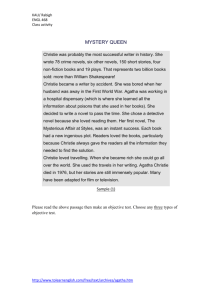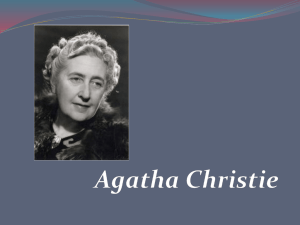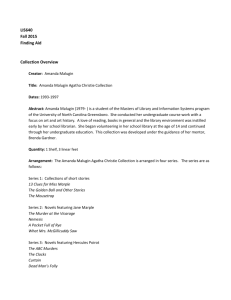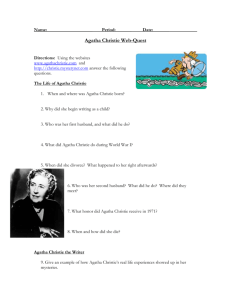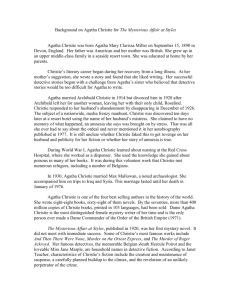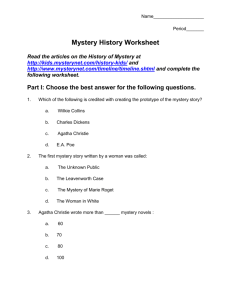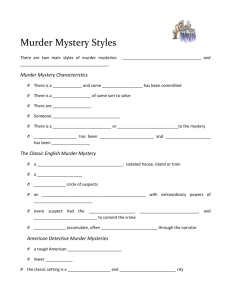() - Milwaukee Repertory Theater
advertisement
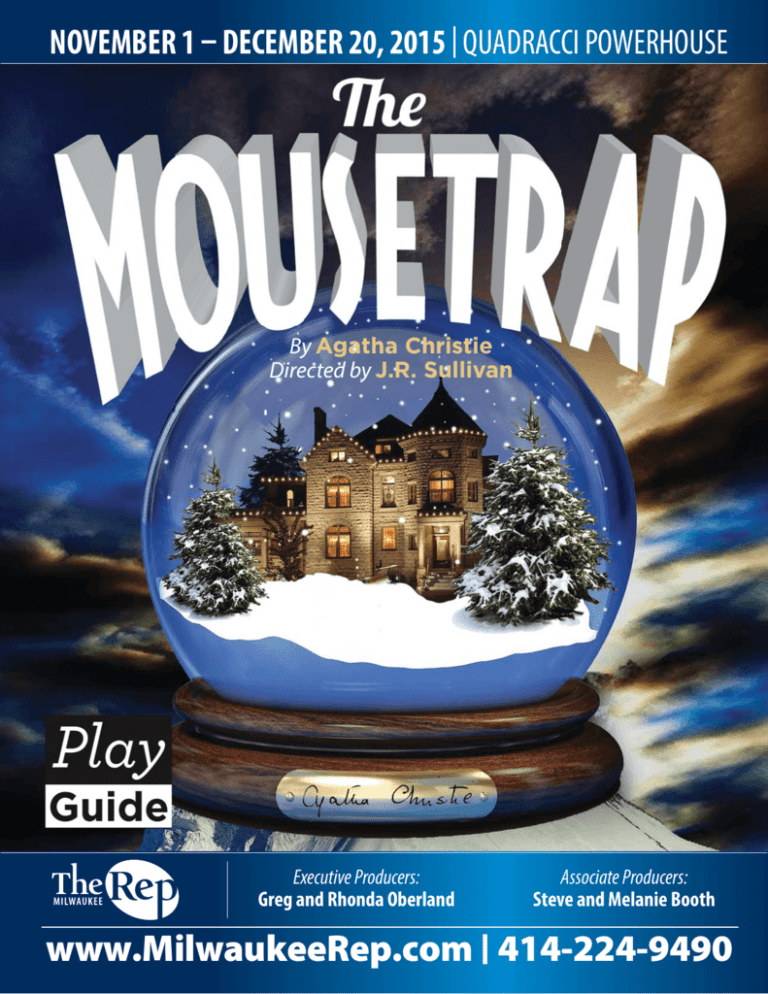
NOVEMBER 1 – DECEMBER 20, 2015 | QUADRACCI POWERHOUSE By Agatha Christie Directed by J.R. Sullivan Executive Producers: Greg and Rhonda Oberland Associate Producers: Steve and Melanie Booth www.MilwaukeeRep.com | 414-224-9490 NOVEMBER 17 - DECEMBER 20, 2015 | QUADRACCI POWERHOUSE By Agatha Christie | Directed by J.R. Sullivan Executive Producers Greg and Rhonda Oberland Associate Producers Steve and Melanie Booth Table of Contents Mark Clements ARTISTIC DIRECTOR Chad Bauman MANAGING DIRECTOR ✸✸✸ PLAY GUIDE WRITTEN BY Kelsey Ingle Education Coordinator Abby Stein Education Intern PLAY GUIDE EDITED BY 3 4 5 6 Agatha Christie’s Works and Famous Characters. . . . . . . . . . . . . . . . . . . . . . . . . 7 Recipe for Murder . . . . . . . . . . . . . . . . . . . . . . . . . . . . . . 8 Fair Play in Murder Most Foul . . . . . . . . . . . . . . . . . . 9 Origin of Three Blind Mice . . . . . . . . . . . . . . . . . . . . 10 The Mousetrap’s Production History. . . . . . . . . . . 11 Agatha Christie Ltd. Historical Context of the Play . . . . . . . . . . . . . . . . . 12 Featured Artists: Lurie Pfeffer, Production Stage Manager . . . . . . . . . . . . . . . . . . . . 13 About Our Production . . . . . . . . . . . . . . . . . . . . . . . . 14 Bibliography . . . . . . . . . . . . . . . . . . . . . . . . . . . . . . . . . . 15 GRAPHIC DESIGN Visiting The Rep . . . . . . . . . . . . . . . . . . . . . . . . . . . . . . 16 Jenny Toutant Education Director Lisa Fulton Director of Marketing and Communications Christopher Chan Eric Reda 2 Cast and Creative Team . . . . . . . . . . . . . . . . . . . . . . . . Synopsis . . . . . . . . . . . . . . . . . . . . . . . . . . . . . . . . . . . . . . . History of the Mystery . . . . . . . . . . . . . . . . . . . . . . . . . Life of Agatha Christie . . . . . . . . . . . . . . . . . . . . . . . . . Executive Producers: Jackie Herd-Barber & Michael Barber The Mousetrap - PlayGuide CAST AND CREATIVE TEAM Mollie Ralston - Kelly Faulkner The young owner and hostess of the newly opened guesthouse Monkswell Manor. Married to Giles Ralston. “You don’t really know anything about me. What I’d done or thought or felt or suffered before you knew me.” –Mollie Ralston Giles Ralston - Matthew Mueller Mollie’s business partner and rather arrogant husband of 1 year. “How much do you know about your husband, Mrs. Ralston?” –Sergeant Trotter Christopher Wren - Brendan Meyer An enthusiastic young guest of the Manor who comes across as mentally unstable. “A madman’s joke. That’s just what makes it so deliciously macabre” –Christopher Wren Mrs. Boyle - Laura Gordon An older woman and guest of the house. Snobbish, hard to please, and a brutal critic of life. “I think that’s a perfectly horrible woman. I don’t like her at all. I’d love to see you turn her out into the snow. Serve her right.” –Christopher Wren Major Metcalf - Jonathan Gillard Daly A retired Army Major and guest of the house. “Major Metcalf is very nice. He won’t be difficult.” Director J.R. Sullivan Scenic Designer Jack Magaw Costume Designer Rachel Laritz Lighting Designer Jason Fassl Sound Designer Lindsay Jones Dialect Coach Jill Walmsley Zager Fight Choreographer Jamie Cheatham Casting Director JC Clementz Stage Manager Lurie Horns Pfeffer Brendan Meyer as Christopher Wren. Photo by Michael Brosilow. –Mollie Ralston Miss Casewell - Kelly Faulkner A young, brash guest of the house who portrays mannish independence and conduct. “When the snow melts, lots of things may have happened.” –Miss Casewell Mr. Paravicini - Greg Vinkler An unexpected and mysterious foreign guest of the house of indeterminate age. A Poirot type. “Who am I? You do not know. Where do I come from? You do not know. Me, I am the man of mystery.” –Mr. Paravicini Detective Sergeant Trotter - Will Allan A strapping young police Sergeant. “If one of you gets murdered, you’ll have yourself to blame.” –Sergeant Trotter www.MilwaukeeRep.com 3 SYNOPSIS It is a dark and very snowy evening. In the blackness, the audience hears the screams and sounds of a murder taking place. When the lights come on, we see Mollie Ralston nervously preparing for the grand opening of her and her husband, Giles’s, guesthouse, Monkswell Manor. Four guests will arrive any minute: Christopher Wren, Mrs. Boyle, Major Metcalf and Miss Casewell. All reservations have been made by correspondence and all are supposedly strangers. Giles comes in from errands covered with snow. He drops his dark coat, light scarf, and hat over an armchair and hides a mysterious brown paper bag in the window seat. While she waits for guests, Mollie hears a news update over the radio describing a murder victim and a brief description of the clothing worn by a suspect who is wanted by police. The clothing: a dark coat, light scarf and hat. Christopher Wren is the first to arrive. He is a quirky, hyperactive young man professing to be an architect. It is very easy to assume he’s mentally unstable because of his direct, unashamed, unapologetic behavior and less than pristine appearance. As Mollie shows Christopher to his room, Giles waits for other guests. Next to enter is Mrs. Boyle. She is an older woman with a large, imposing physique. She has a bad attitude and is clearly set in her ways. In fact, if things are not done to her approval, she makes no attempt to hide her dislike. From the moment we meet her, nothing escapes her criticism. No one met her at the train station and she was forced to share a cab with another person. Mollie is too “young and inexperienced.” The accommodations are “misleading.” And so it goes on… Major Metcalf, a retired Army Major, is Mrs. Boyle’s fellow cab passenger. After paying for the taxi, he comes in, shortly followed by Miss Casewell, a manly woman wearing a dark coat and light scarf. As they are shown to their quarters, Christopher’s eccentric behavior continues as he hides, snoops, and wanders through the house. He seems to be flirting with Mollie. Staggering into the Manor without a reservation is Mr. Paravicini. He is dark, foreign, and elderly with a flamboyant moustache resembling one of Agatha Christie’s most famous characters, Hercule Poirot. The following afternoon, the guests carry on varied bits of conversation as they come and go from the drawing room. The snow has gotten WARNING: Spoilers! Much of the plot can be found here, though NOT the identity of the murderer. noticeably thicker outside. Out of the blue, Mollie receives a phone call from the police informing her that an officer will soon be paying them a visit with important information. The guests and the Ralstons speculate the reasons for a law enforcement visit and doubt that this person would be able to get through the thick snow. Suddenly, young Sergeant Trotter appears at the window having arrived on skis. At this point, Major Metcalf attempts to place an outgoing phone call and discovers the line to be dead. Sergeant Trotter then informs everyone that the reason he is there is to warn them that at the crime scene for the murder discussed on the radio, was a note with the address of Monkswell Manor. Trotter says he is there to find some connection with the people at the guesthouse and the murder victim. He begins questioning all present, yet there seem to be no connections. Everyone begins to suspect everyone else, especially when Trotter informs the group that the phone line has been intentionally cut. As everyone leaves to go about their own business, Mrs. Boyle, alone in the room goes to the radio to adjust programs. Suddenly, a hand reaches in through a doorway, shuts off the lights, and cranks up the radio volume. The audience hears a struggle and a body falling. Mollie appears from the kitchen, turns on the lights, turns down the radio and discovers Mrs. Boyle’s strangled body lying in front of the sofa. Mollie’s screams bring everyone running to the murder scene. Trotter increases the pressure and urgency of his interrogations. He tries to piece together where everyone was at the time of this murder. They all have a rational explanation for their whereabouts. Trotter does not seem to be making any progress. Finally he gets the idea to reenact everyone’s trajectory from their assumed locations to the main room at the time they heard Mollie scream. However, he throws in a little monkey wrench by switching up everyone. He is convinced that this is the tactic that will prove who has been lying and who the murder is. Does it work? You will have to wait and see… The long-held motto of The Mousetrap is “Keep the Secret.” Please continue this tradition by refusing to tell whodunit to those who have not seen the play for themselves! The Cast of The Moustrap. Photo by Michael Brosilow. 4 The Mousetrap - PlayGuide HISTORY OF THE MYSTERY 1700’s - One Thousand and One Nights “The Three Apples” One of the first mystery stories is found in the collection, Arabian Nights. In it, a young woman is found cut in pieces in a locked trunk. Whodunit? 1841 - Edgar Allen Poe The Murders in the Rue Morgue Poe’s character, C. Auguste Dupin, became the first fictional detective. 1868 - Wilkie Collins The Moonstone Considered by some to be the first true English detective novel, it laid out ground rules for other detective novels. A sketch of Edgar Allen Poe’s Auguste C Dupin. Photo Credit: www.homoliteratus.com 1878 - Anna Katherine Green The Leavenworth Case The first woman to write a detective novel, and an inspiration to Agatha Christie. 1887 - Sir Arthur Conan Doyle A Study in Scarlet The first of the Sherlock Holmes series. 1920 - Agatha Christie The Mysterious Affair at Styles Christie’s first detective novel. She wrote more than 80 books, spanning a career of 50-plus years. 1929 - Manfred B. Lee and Frederic Dannay (aka Ellery Queen) The Roman Hat Mystery America was later to the punch with mystery novels. Stateside, detective fiction reached its zenith with this immensely popular book. 1933 - Erle Stanley Gardner The Case of the Velvet Claws The introduction to Perry Mason, criminal lawyer who became famous for his quirky courtroom questioning methods. 1947 - Mickey Spillane I, The Jury Pulp Magazines were inexpensive fiction magazines that contained a wide variety of sensational tales, mystery stories being a favorite genre. The first appearance of ultra-tough guy, detective Mike Hammer. These grittier novels had a strong emphasis on sex and violence. LOCKED ROOM MYSTERY A murder victim is found in a sealed enclosure and the detective must discover the murderer and their motive. Both The Murders in the Rue Morge and The Moonstone employ this method. www.MilwaukeeRep.com THE MYSTERY OF EDWIN DROOD Charles Dickens’ unfinished final book is considered by some to be the perfect mystery since we will never know the intended ending. Raymond Burr as Perry Mason in CBS’s TV Series of the same name. Photo Credit: CBS Photo Archive 5 LIFE OF AGATHA CHRISTIE Early Years: Agatha Christie was born Agatha Mary Clarissa Miller on September 15, 1890, in Torquay, Devon, in the southwest part of England. She was educated at home. Christie enjoyed creating and playing with fantasy and characters as a child. At age 16, she went to Paris to study music. The Firsts: In 1914, she married Colonel Archibald Christie, a Royal Flying Corps pilot, and became a nurse during World War I. Her first book, The Mysterious Affair at Styles, was published in 1920. Agatha Christie and her first husband. Tough Times: In 1926, Christie released one of her personal favorite books, The Murder of Roger Ackroyd, a huge success. It was eventually considered a classic of its genre. Sadly, in the same year, her mother passed away and her husband admitted to having an affair. Christie suddenly vanished in a much-publicized disappearance, and was discovered nearly two weeks later at a hotel in Harrogate– registered under the name of her husband’s mistress! The official explanation was that Christie was suffering from loss of memory caused by stress, and Christie notably made virtually no mention of the event for the rest of her life. Denouement: Christie and Archibald divorced in 1928; and in 1930, she married archaeology professor Max Mallowan. She would accompany Max on several expeditions. Writing well into her later years, Christie wrote more than 70 detective novels as well as short fiction. Though she also wrote romance novels like Unfinished Portrait (1934) and A Daughter's a Daughter (1952) under the name Mary Westmacott, Christie's success as an author of sleuth stories has earned her titles like the "Queen of Crime" and the "Queen of Mystery." Christie was made a dame in 1971. In 1974, she made her last public appearance for the opening night of the play version of Murder on the Orient Express. Christie died on January 12, 1976. Young Agatha Christie. MYSTERY TERMINOLOGY The Winterbrook House, one of many houses Agatha Christie owned all over England. RED HERRING: a misleading clue that throws off the investigation. The phrase comes from the salted, very smelly fish, called a red herring which some stories say fugitives used to throw bloodhounds off the scent. SUSPECT: a person who may have committed a crime. WHODUNIT: a logic puzzle mystery that may be solved by any observer by piecing together clues. ALIBI: a claim of innocence in a crime because of your presence somewhere else during the time of the crime. In The Mousetrap, no one has an alibi that can be confirmed by anyone else, which makes them all potentially guilty. MOTIVE: a reason or desire to act. In the case of a mystery, a motive is a reason someone has to commit a crime or murder. Agatha Christie and her second husband. 6 The Mousetrap - PlayGuide AN ABRIDGED LIST OF AGATHA 1920 1922 1923 1924 1925 1926 1927 1928 1929 1929 1930 1930 1931 1932 1932 1933 1933 1934 1934 1934 1934 1935 1936 1936 1936 The Mysterious Affair at Styles The Secret Adversary Murder on the Links The Man in the Brown Suit The Secret of Chimneys The Murder of Roger Ackroyd The Big Four The Mystery of the Blue Train The Seven Dials Mystery Partners in Crime The Mysterious Mr. Quin The Murder at the Vicarage The Sittaford Mystery Peril at End House The Thirteen Problems Lord Edgware Dies The Hound of Death Murder on the Orient Express Why Didn’t They Ask Evans? Parker Pyne Investigates Three Act Tragedy Death in the Clouds The ABC Murders Murder in Mesopotamia Cards on the Table 1937 1937 1937 1938 1938 1939 1939 1939 1940 1940 1945 1946 1947 1948 1948 1949 1950 1950 1951 1952 1952 1953 1953 1954 1955 CHRISTIE’S WORK Dumb Witness Death on the Nile Murder in the Mews Appointment with Death Hercule Poirot’s Christmas Easy to Kill And Then There Were None The Regatta Mystery Sad Cypress One, Two, Buckle My Shoe Sparking Cyanide The Hollow The Labours of Hercules Taken at the Flood Witness for the Prosecution Crooked House A Murder is Announced Three Blind Mice They Came to Baghdad Mrs. McGinty’s Dead They Do It with Mirrors After the Funeral A Pocket Full of Rye Destination Unknown Hickory Dickory Dock 1956 1957 1958 1959 1960 1961 1961 1962 1963 1964 1965 1966 1967 1968 1969 1970 1971 1971 1972 1973 1974 1975 1976 Dead Man’s Folly 4.50 from Paddington Ordeal by Innocence Cat Among the Pigeons The Adventure of the Christmas Pudding The Pale Horse Double Sin The Mirror Crack’d from Side to Side The Clocks A Caribbean Mystery At Bertram’s Hotel Third Girl Endless Night By the Pricking of My Thumbs Hallowe’en Party Passenger to Frankfurt Nemesis The Golden Ball Elephants Can Remember Postern of Fate Poirot’s Early Cases Curtain Sleeping Murder AGATHA CHRISTIE’S CLASSIC DETECTIVES Agatha Christie tended to use detectives who showed up in more than one of her novels. Here are some of her most famous gumshoes. David Suchet as Hercule Poirot in the ITV television series. Photo Credit: UK Daily Mail. Julia JJu Jul uliiaa Mck uli ul Mc M Mcke Mckenzie ckkenz eenzi en nzie ie as as Mis Mi Mis Miss i sM Marple arpple ar arp le in in the the th he ITV TV television TV tteelev lev le evvisi isiionn ser is isi sseries. er eries ies ie ies ees. s. Photo Credit: Daily Mail. Pho Ph Pho h too Cre Credit CCr redit re diitit:t: UUKK DDail dit: aily M aily ail aill. ai ail During the First World War there were Belgian refugees in most parts of the English countryside, which is where the inspiration for Hercule Poirot arose. Christie imagined him as a great detective in Belgium transplanted to England. Hercule Poirot is an arrogant, eccentric, and immodest detective who finishes every case dramatically. He loves elegance, beauty, precision, and having the final word. Christie so loved the character of Poirot that she considered the fictional detective a friend, partner, and respectfully acknowledges that he was largely responsible for her success. Miss Marple first came into being in 1927 via The Thirteen Problems, serialized in the Sketch Magazine. She was an instant success proving herself the match of every murderer she met. Agatha Christie modeled Miss Marple after her grandmother with some slight differences. Miss Marple was more fussy and spinsterish than her grandmother. Miss Marple had three loves in life: knitting, gardening, and gossip. With every stitch she was solving a crime. www.MilwaukeeRep.com In The Mousetrap, it is said in the stage directions that Mr. Paravicini is a “Poirot type,” even though he is not the detective of the story. David Walliams and Jessica Raine as Tommy and Tuppence in BBC One’s Partners in Crime. Photo Credit: BBC. Young partners, international spies, and lovers: Tommy and Tuppence are childhood friends who bump into each other at the train station. It is post WWI and, needing money, Tuppence asks Tommy to form Young Adventurers Ltd. Their motto, taken from the book The Secret Adversary, is “two young adventurers for hire, willing to do anything, go anywhere... No unreasonable offer refused." Coincidentally, in 1928 The Secret Adversary became the first of Christie’s novels to be adapted for film. Christie recalls enjoying writing their stories the most. The energy of her young characters fed her creativity. Tommy and Tuppence aged with the times, beginning in their twenties, and in their last book were in their seventies. 7 RECIPE FOR MURDER CONVENTIONS OF A WHODUNIT WHAT INSPIRED THE MYSTERY GENRE? A classical mystery follows a formula of plot points, characters, and settings that are familiar to the audience. Agatha Christie is especially known for these types of stories which will generally contain: 1. A secluded English country home (or other such secluded location) that is for the most part inaccessible, narrowing the playing field of suspects who could have committed the crime 2. A large cast of characters with a wide range of motives and secrets 3. A confusing clue-puzzle that the reader/audience could potentially figure out 4. A detective y y, usuallyy byy 5. The reveal of the murderer at the end of the mystery, calling all suspects together, the detective giving a summation of events, and then accusing the perpetrator. Gothic Horror is a fiction genre characterized by enticing terror, the intense emotions of Romanticism, and monsters, be them supernatural or manmade. Gothic Horrors were huge inspirations for Mystery stories. Some classic examples of Gothic Horror are: Bram Stoker’s Dracula Mary Shelley’s Frankenstein Emily Brontë’s Wuthering Heights Edgar Allen Poe’s The Fall of the House of Usher Gaston Leroux’s The Phantom of the Opera Gothic Horror still exists today. Stephen King is largely cconsidered to be a Gothic author. Though the first instance of GGothic Horror was said to be Horace Walpole’s The Castle of OOtranto in 1764, and had its Victorian heyday in the late 119th, early 20th century. The classic Parker Brothers detective game of Clue. Bela Lugosi as Count Dracula in Universal Picture’s 1931 Dracula. AGATHA CHRISTIE IS THE QUEEN OF THE MYSTERY GENRE – SELLING LESS BOOKS ONLY THAN SHAKESPEARE AND THE BIBLE! WHAT DID THE MYSTERY INSPIRE? The mysteries that Agatha Christie and her contemporaries write have a certain coziness to them. Most plots do not dwell on the dreadfulness of murder, and instead tie up all the plot lines in a neat package. In the late 1940s to the early 1950s, a new genre emerged called Film Noir. This is a cinematic term that refers the hard-boiled American detective who investigates crimes that may not have a clear right or wrong answer, and are set in the underbelly of society, normally dealing with gangsters, smugglers, and femme fatales. Another offshoot of the mystery genre is a much more interactive idea of the stories. Board games that revolve around solving a mystery can be played over and over with different culprits each time. The most popular is Clue, but others exist like Kill Doctor Lucky, Mystery of the Abbey, or Sleuth. Radio shows like Suspense took the listener through an entire mystery tale in a weekly installment format. Murder mystery dinner theater is immensely popular, and recently, you can even find your own mystery in a box with parties you can purchase and host, inviting your friends to play as suspects. 8 Humphrey Bogart as Philip Marlowe in Warner Brother’s 1946 film, The Big Sleep. Sleep Photo Credit: Classic Cinema Images. The Mousetrap - PlayGuide FAIR PLAY IN MURDER MOST FOUL In writing a mystery, some authors, wrote outlines that all mystery stories should follow. The most notable of these are Father Ronald Knox’s 1929 “Ten Commandments” of Mystery Fiction, also called “Knox’s Decalogue,” and S.S Van Dine’s 1928 “Twenty Rules for Writing Detective Stories.” Father Knox was an author, priest, and one of the founding members of The Detection Club which also included Agatha Christie. S.S. Van Dine was a pseudonym for Willard Huntington Wright, the creator of the popular detective Philo Vance. Many authors used these rules as guidelines instead of hard and fast laws. Here are a few rules taken from both of these important guiding works: The reader must have equal opportunity with the detective for solving the mystery. The detective himself, or one of the official investigators, should never turn out to be the culprit. There simply must be a corpse in a detective novel, and the deader the corpse the better. There must be but one culprit, no matter how many murders are committed. he culprit. A servant must not be chosen by the author as the uled out as All supernatural or preternatural agencies are ruled a matter of course. owable, Not more than one secret room or passage is allowable, uilding and such a passage may only be in a house or building for which it is appropriate by age or purpose. Twin brothers and doubles generally, must not appear unless we have been prepared for them. es? Does The Mousetrap follow all of these rules? It certainly bends at least one. MURDER ON THE ORIENT EXPRESS Hercule Poirot is traveling on the Orient Express. One of the passengers, Samuel Ratchett, has been receiving threatening letters. Afraid for his life, he asks Poirot for protection. Does Poirot take the job, or will he be investigating another murder? Christie used the real life kidnapping of Charles Lindbergh’s baby as inspiration for this story’s underlying plot. Murder on the Orient Express has been adapted many times in the form of radio plays, films, television, and computer games. AND THEN THERE WERE NONE Ten strangers. Ten secrets. Ten crimes. One island. This kind of mystery, in which guests are trapped in a deserted location and they start to die one-by-one, is so popular that it has become a cliché. The BBC adaptation of And Then There Were None was the first of her novels to be produced on TV. International adaptations have been done in India, Germany, US, France, and Russia. It has even been given a Bollywood musical version in the film, Gumnaan. “THE BUTLER DID IT” IS A COMMON TROPE THAT WAS FIRST POPULARIZED BY MARY ROBERTS RINEHART IN HER BOOK THE DOOR, PUBLISHED IN 1930. THE MYSTERIOUS AFFAIR AT STYLES There has been a murder at Styles Court. The victim is a wealthy heiress eiress and the weapon, poison. Detective Hercule Poirot has been asked to solve the case. To find the truth, Poirot can either follow the evidence, or re-think it. This is her first book, and the catalyst for writing it was a bet. Her sister, Marge, though Christie could not write a decent detective novel. Boy, was she wrong! After WWI, Christie worked in the apothecary dispensary. It is because of this background that she became an expert on poisons. This is the very first introduction to Hercule Poirot. In July 1935 the book made publishing history by being one of the first ten novels to be published by Penguin Books when they first launched. www.MilwaukeeRep.com CURTAIN: POIROT'S LAST CASE CUR Just as Styles was the location of the birth of Hercule Poirot, so was it for his death. Physically immobile from severe arthritis, Poirot’s mind is still sharp enough to solve his final case. Serial killer “X” must be stopped once and for all. Agatha Christie wrote it during World War II, as a gift for her daughter should she not survive the bombings. Many fans internationally refused to read it knowing that Poirot comes to his end. The New York Times ran an obituary for Poirot, the only fictional character to have one. 9 ORIGIN OF THREE BLIND MICE “Three Blind Mice” was the original title of the The Mousetrap, and the motif of three blind mice is incredibly important to the plot of the story. But where did the rhyme come from? The origin of the words to Three Blind Mice are based in English history. The “farmer's wife” refers to the daughter of King Henry VIII, Queen Mary I. Mary was a staunch Catholic and her violent persecution of Protestants led to the nickname of “Bloody Mary.” The reference to “farmer's wife” in Three Blind Mice refers to the massive estates which she and her husband, King Philip of Spain, possessed. The three blind mice were symbols for three noblemen who adhered to the Protestant faith who were convicted of plotting against the Queen - she did not have them dismembered and blinded as inferred in Three Blind Mice - but she did have them burnt at the stake! THE TUNE: The tune can be traced back to Thomas Ravenscroft (1582-1635). He was a composer most noted for composing British folk tunes and writing music in rounds and catches. He is also known for his street cries and vendor songs. Deuteromelia is one of his collections of music written in 1609 where “Three Blind Mice” is first seen A drawing of Queen Elizabeth I. Interestingly, the rhyme is inspired by Queen Elizabeth I, and Queen Elizabeth II has attended the play that was inspired by the poem. 10 THE TALE: In the play, we only hear a snippet of the words and the haunting tune from Three Blind Mice. The complete version is much darker, telling of starvation, sickness, persecution, and insanity. Like many fairy tales and folk lore, the original is quite gruesome. Mr. Paravicini puts it best when he says, “just what a child would adore. Cruel little things, children.” Three Small Mice Three Small Mice Pined for some fun Pined for some fun They made up their minds to set out to roam; Said they, “’Tis dull to remain at home,” And all the luggage they took was a comb, These three Small Mice Three Starved Mice Three Starved Mice Came to a Farm Came to a Farm The Farmer was eating some bread and cheese; So they all went down on their hands and knees, And squeaked, “Pray, give us a morsel, please,” These three Starved Mice. Three Sad Mice Three Sad Mice What could they do? What could they do? The bramble hedge was most unkind: It scratched their eyes and made them blind, And soon each Mouse went out of his mind, These three Sad Mice. Three Bold Mice Three Bold Mice Came to an Inn Came to an Inn “Good evening, Host, can you give us a bed?” But the Host he grinned and he shook his head; So they all slept out in a field instead, These three Bold Mice. Three Glad Mice Three Glad Mice Ate all they could Ate all they could They felt so happy they danced with glee; But the Farmer’s Wife came in to see What might this merry-making be Of three Glad Mice. Three Blind Mice Three Blind Mice See how they run See how they run They all ran after the Farmer’s Wife, Who cut off their tails with the carving knife. Did you ever see such a sight in your life As three Blind Mice? Three Cold Mice Three Cold Mice Woke up next morn Woke up next morn They each had a cold and a swollen face, Through sleeping all night in an open space; So they rose quite early and left the place, These three Cold Mice. Three Poor Mice Three Poor Mice Soon changed their tone Soon changed their tone The Farmer’s Wife said, "What are you at, And why were you capering round like that? Just wait a minute: I’ll fetch the Cat" Oh dear! Poor Mice. Three Sick Mice Three Sick Mice Gave way to tears Gave way to tears They could not see and they had no end; They sought a Chemist and found a Friend He gave them “Never too late to mend,” These Three Sick Mice. Three Hungry Mice Three Hungry Mice Searched for some food Searched for some food But all they found was a walnut shell That lay by the side of a dried-up well; Who had eaten the nut they could not tell, These three Hungry Mice. Three Scared Mice Three Scared Mice Ran for their lives Ran for their lives They jumped out on to the window ledge; The mention of “Cat” set their teeth on edge; So they hid themselves in the bramble hedge, These three Scared Mice Three Wise Mice Three Wise Mice Rubbed rubbed away Rubbed rubbed away And soon their tails began to grow, And their eyes recovered their sight, you know; They looked in the glass and it told them so. These three Wise Mice. And a surprise happy ending! Three Proud Mice Three Proud Mice Soon settled down Soon settled down The name of their house I cannot tell, But they’ve learnt a trade and are doing well. If you call upon them, ring the bell Three times twice. The Mousetrap - PlayGuide HISTORICAL CONTEXT OF THE MOUSETRAP CENTRAL HEATING Heating the house is referenced throughout, and the job normally falls to Giles who “tends to the Aga” and “refills the coalscuttles.” The Aga, as they call it, is actually an AGA Cooker which was a relatively new innovation in cooking that was based on the principle that cast-iron will retain heat from a low-intensity, continuously-burning source. In fact, an AGA was so popular in country houses in England, like Monkswell Manor, that it gave rise to the literary term “AGA Saga,” which refers to a story set in upper class English society. Advertising claimed that AGA Cookers could heat an entire house, yet they did this very poorly. Plus, coal was rationed in England until 1958. The Ralstons most likely didn’t have enough to keep a big house warm, which is why Monkswell is perpetually chilly. “Coke” is the fuel used to heat the AGA. Coke is coal that has undergone a process that eliminates coal’s black smoke and distinctive smell. Coalscuttles are metal buckets used to store the coke near the various heaters to restock the fuel supply. As seen in the image, coalscuttles have an angular spout to make restocking the fire easy. A coalscuttle. COUNTRY HOUSES AND DOMESTIC SERVANTS Post-war England went through a massive social shift in class structure. Particularly relevant to the The Mousetrap are the changes in domestic servants. Our play is set in a country home that most likely was a midland manor house in which landed gentry or other upper class citizens resided, living off the wealth of the land and passing the estate down through the generations, as happened with the Ralstons. Throughout the first half of the 20th century there was war, depression, and expanded job opportunities for the lower class. Domestic servitude became less appealing, and servants that “lived in” their masters’ homes declined due to the fact that they were more expensive to employ, and many households had learned to “do without” during the war effort. With the advent of labor-saving devices, housewives could manage a household with less outside help, though some places, like Monkswell Manor, would continue to employ “daily women,” who functioned similarly to contemporary home cleaning services. You will see the clash of old and new expectations of keeping a home in Mollie and Mrs. Boyle’s expectations of a “proper staff.” Mrs. Boyle holds the old-fashioned view that a full staff is required for the running of a guest house, while Mollie and Giles feel themselves capable of doing all the domestic labor themselves. Judges Country House Hotel in Kirklevington. SLANG USED IN THE PLAY Spiv: a man who makes money dishonestly Tabby: a spiteful, older female gossip Chilblains: an inflammation of the hands and feet when exposed to cold and moisture Tinpot: paltry, shoddy, not well-made. The origin of this phrase came from the believed inferior quality of a tin pot www.MilwaukeeRep.com 11 PRODUCTION HISTORY OF THE MOUSETRAP Nottingham’s Nottingh g ams Theatre Roy Royal yal TAKING A LEAF OUT OF SHAKESPEARE’S BOOK In 1947, Agatha Christie wrote Three Blind Mice as a short radio play for the Royal family. The stage version had to be renamed since the original title had already been used in a previous production. “The Mousetrap” refers to the play-within-the-play in Shakespeare’s Hamlet. The Mousetrap first entered the record books on April 12, 1958 when it became the longest running show of any kind in the history of British Theatre. Originally produced in Nottingham at the Theatre Royal, it toured England before embarking on a 32 year run at The New Ambassadors Theatre in London. In March 1974, it moved next door to the St. Martin’s Theatre where it currently remains. It has continuously been running for more than 60 years. In 2000, the set was replaced for the first time during the run at St Martin's Theatre, still to the same design as the original. This task was completed over a weekend without the loss of a performance. Some cast members are in the Guinness Book of Records: David Raven as the 'Most Durable Actor' for 4575 performances as Major Metcalf and the late Nancy Seabrooke for a record breaking 15 years as an understudy. St. Martin’s Theatre in London’s West End The contract terms of the play state that no film version can be made until the West End show has been closed for at least six months, and since it is still running—no official film has been made! On an occasion such as cast changes or milestone anniversary performances, a cake is ceremoniously cut with a sword. The cake is in the shape of a ticker counter that keeps track of the amount of performances. This is in celebration of 26,000. Photo Credit: St. Martin’s Theatre. Agatha Christie gave the rights to The Mousetrap to her grandson, Mathew Prichard, for his 9th birthday. On November 18, 2012 for one performance only, The Mousetrap celebrated its 25,000th performance (60th anniversary) with a celebrity-filled cast. We’ve included some of their most notable titles American audiences might recognize: Hugh Bonneville (Downton Abbey), Nicholas Farrell (The Iron Lady), Iain Glen (Game of Thrones), Tamsin Greig (Emma-TV mini-series), Miranda Hart (Call the Midwife), Harry Lloyd (The Theory of Everything), Sir Patrick Stewart (Star Trek) and Julie Walters (Harry Potter). The Agatha Christie memorial statue was unveiled for this occasion. Photo Credit: St. Martin’s Theatre. Photo Credit: UK Dailyy Mail. 12 The Mousetrap - PlayGuide Stage of the St. Martin’s Theatre in London’s West End Photo Credit: Wikimedia.org FEATURED ARTIST: LURIE PFEFFER PRODUCTION STAGE MANAGER The original home of The Mousetrap, Nottingham’s Theatre Royal, mounted another production of the play when it celebrated its 50th year. Photo Credit: Nottingham’s Theatre Royal. “A Stage Manager has to know the show inside and out, because not everybody realizes: the director goes away on opening night,” says Lurie Pfeffer, Production Stage Manager for The Mousetrap. Even if you are a fan of theater, you may not have heard of a Stage Manager. So what do they do? “The word we use a lot is ‘facilitator,’” says Pfeffer to describe her role. A typical day for a Stage Manager could include preparing rehearsal halls with all scenic, prop, and costume elements that are needed, keeping track of blocking (an actor’s movement onstage), taking notes on artistic decisions, and serving as the go-between for the director and the producing company. The Stage Manager is also heavily involved in “Tech Week,” the final days before the opening of a show, as well as “calling” the show during the actual performances. In other words, they inform the crew members operating the light and sound board when to hit certain cues, are in charge of getting actors to their places, among plenty of other responsibilities. There are about a dozen Stage Managers employed at The Milwaukee Repertory Theater this season. Currently, three of them are involved in The Mousetrap. “A Stage Manager’s job is to maintain the artistic integrity of the show,” says Pfeffer. After the final rehearsal, no more changes are allowed—the show is in the final form that the audience will see for the entire run of the show. The production is “frozen,” and the reins are handed to the Stage Manager. Her Majesty Queen Elizabeth II attended the 50th Anniversary Royal Gala Performance on November 25th, 2002. Pictured above is said to be Agatha Christie’s last public appearance when The Queen attended the premiere of the 1974 movie, Murder on the Orient Express. Photo Credit: Babelio. Though this is only Pfeffer’s second production with The Milwaukee Repertory Theater after Dreamgirls, she has plenty of experience in the business. Originally from New York, Pfeffer got her first stint at The Old Globe Theatre in San Diego which quickly offered her an equity position. She remained there for five years, after which she worked as a freelance Stage Manager. Since then, she has been to Broadway with three shows, once with Billy Crystal’s one-man show, 700 Sundays, a production she spent the better part of ten years with, touring Canada, the US, and Australia, and on the way met Oprah and Barbara Streisand. “I didn’t start Stage Managing until I was in my mid-40s… I think it is important that people know you don’t have to go to school specifically for Stage Management to do it well.” Pfeffer cited that some of the most important qualities of a Stage Manager are, “focus, organization, and being good with people.” It is a great job for those who love the stage since “you can touch on all aspects of live theatre.” She has enjoyed working on The Mousetrap, and says that “the fun of it is in providing the audience with hints that may or may not solve the mystery.” She says the only clue she will give away is that the audience should, “pay close attention to the relationships between characters that you may not have first thought knew one another.” The Mousetrap is unique in how reproducible it is. “Unlike a Shakespeare play that could be set in outer space or the prehistoric times,” The Mousetrap’s set will be recognizable to an audience. Getting the set, lights, costumes, props, sound, and actors all on the same page happens in one week, and, “the Stage Manager is the hub, since we bring all the technical elements together.” Pfeffer describes this time of the production like, “putting together a puzzle when you don’t know the size or the shape of any of the pieces.” It is incredibly difficult, and that’s why there are Stage Managers. After The Mousetrap, Pfeffer will be involved in The Invisible Hand and Fences. You may never see Lurie in a production, she’s “happiest on the other side of the stage,” but you will certainly see her hard work apparent in The Mousetrap. pp p www.MilwaukeeRep.com 13 ABOUT OUR PRODUCTION Smoking was very common, almost fashionable, in 1950s England. By state law, no tobacco products are used onstage. Instead, stripped and roasted cocoa hulls are used in the pipes and cigarettes, however, the cigar is electric. There are two different types of snow used onstage. First, the flame retardant paper or plastic that fall from shaker boxes during Act I, and actual shaved ice that characters will brush off their outerwear when they enter the Manor. The play has many red herrings—props or clues that are made to seem as if they are significant when they may only be misleading information. The large cast means that many pieces of furniture must be reduced in size so cast and set can all fit on the same stage at once. Props and furniture are lent to and borrowed from area theaters, particularly those who are members of the Society of Properties Artisan Managers (SPAM). 14 The Mousetrap - PlayGuide BIBLIOGRAPHY Three chandeliers are used during the play. Props artisan made two from scratch, but the third is making its fourth appearance on The Rep’s stage. It has previously been seen in Picasso at the Lapin Agile, in pieces during The Whipping Man, and restored for The Color Purple. Alburger, Mark. "Music History Thomas Ravenscroft (1582-1635) - Blind Mice." Thomas Ravenscroft (1582-1635). N.p., n.d. Web. 28 Oct. 2015. "Agatha Christie Biography." The Biography.com Website. A&E Networks Television. Web. 21 Oct. 2015. Agatha Christie Limited. Agathachristie.com. Christie Archive Trust, n.d. Web. 21 Oct. 2015. Alchin, L.K. rhymes.org.uk (Nursery Rhymes lyrics and Origins) e.g. Retrieved November 16 2007 from www.rhymes.org.uk Brooks, Victoria. Dobbs, Richard. Maguire, Una. “Partners in Crime – major new BBC One drama for Agatha Christie’s 125th celebration year” www.bbc.co.uk BBC. n.d. Web. 4 Nov. 2015. The furniture and set dressings were chosen to make the set look as if many people ranging from the Tudor Gothic era to present (1952) have lived in it, and left some of their belongings behind. Chan, Christopher, Agatha Christie Ltd. 28 Oct. 2015. E-mail. Morris, Tom. "File:Agatha Christie at Great Newport Street.jpg." For "agatha+christie+photos+" N.p., 26 may 2013. Web. 26 Oct. 2015. MysteryNet and Newfront Productions, Inc. “Mystery Time Line. History of the Mystery” MysteryNet. 2012. NottmPostEG. "Review: The Mousetrap, Theatre Royal." www.nottinghampost.com. Nottingham Post, may 15, 2013. Web. 27 Oct. 2015. "Search Results for Photos, Prints, Drawings, Agatha+Christie." The Library of Congress. N.p., n.d. Web. 21 Oct. 2015. St. Martin’s Theatre. “Mousetrap History.” www.the-mousetrap.co.uk. N.p., n.d. Web. 26 Oct. 2015. Stephen Moss. "The Mousetrap at 60: Why Is This the World's Longest-running Play?" www.theguardian.com. The Guardian, n.d. Web. 26 Oct. 2015. Stew, Arthur. “Heroes and Villains: Humphrey Bogart in ‘The Big Sleep’” classiccinemaimages.com. Classic Cinema Images. n.d. Web 4 Nov. 2015. Wigg, David. “Who dunnit, Miss Marple? Julia Mckenzie on Stepping into the Shoes of a Spinster Sleuth” www.dailymail.co.uk. The Daily Mail. n.d Web. 4 Nov. 2015 Wilson, A. N. “Unseen for 60 years, the Mail proudly presents Agatha Christie’s lost masterpiece, The Capture of Cerberus.” dailymail.co.uk, Daily Mail. n.d. Web. 4 Nov. 2015. A CNC router cut the outline of the set’s floor. This computer controlled cutting machine is also responsible for the intricate radiator designs. The radiator itself was made with super-heated lightweight plastic that was molded over a negative on a vacuum former. www.MilwaukeeRep.com 15 VISITING THE REP Milwaukee Repertory Theater’s Patty and Jay Baker Theater Complex is located in the Milwaukee Center downtown at the corner of Wells and Water Streets. The building was formerly the home of the Electric Railway and Light Company. The Ticket Office is visible on the left upon entering the Wells Street doors. The Quadracci Powerhouse is located on the second level and can be accessed via the escalator or elevator. THE REP VALUES YOUR SUPPORT Financial support enables The Rep to: ✯ Advance the art of theater with productions that inspire individuals and create community dialogue; ✯ Provide a richer theater experience by hosting Rep In Depth, Talkbacks, and creating Play Guides to better inform our audiences about our productions; ✯ Educate over 20,000 students at 200+ schools in the greater Milwaukee area with Rep Immersion Day experiences, student matinees, workshops, tours and by making connections with their school curriculum through classroom teaching programs such as Reading Residencies and Scriptworks; ✯ Maintain our commitment to audiences with special needs through our Access Services that include American Sign Language interpreted productions, captioned theater, infrared listening systems and script synopses to ensure that theater at The Rep is accessible to all; ✯ Educate the next generation of theater professionals with our Artistic Intern Program which gives newly degreed artists a chance to hone their skills at The Rep as they begin to pursue their theatrical careers. We value our supporters and partnerships and hope that you will help us to expand the ways Milwaukee Rep has a positive impact on theater and on our Milwaukee community. Donations can be made on our website at www.MilwaukeeRep.com or at 414-224-9490. THE REP RECEIVES SUPPORT FROM: The Lynde and Harry Bradley Foundation The Richard & Ethel Herzfeld Foundation David and Julia Uihlein Charitable Foundation

